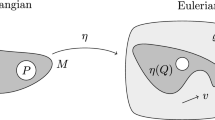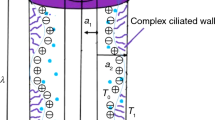Abstract
Observations of flow through a collapsible tube with two elastic constrictions in series show that it exhibits a type of negative-resistance behaviour, where increasing the resistance of the downstream constriction decreases the overall resistance to flow. This behaviour occurs because the resistance to flow of an elastic constriction is greater in the transonic configuration than in the sonic, and it cannot be accounted for by the 1-dimensional theory of flow through such tubes. The possibility of conventional negative resistance is demonstrated, and experimental observations of relaxation oscillations are presented and interpreted in terms of a negative-resistance region.
Sommaire
Les observations d'écoulements par un tube très souple comportant deux étranglements élastiques en série, montrent que ce tube présente un comportement du type résistance négative, on tout accroissement de la résistance de l'étranglement aval réduit la résistance globale à l'écoulement. Ce comportement s'explique du fait que la résistance à l'écoulement d'un étranglement élastique est plus élevée dans la configuration transonique que dans la configuration sonique et ne peut pas être imputée à la théorie unidimensionnelle de l'écoulement à travers de tels tubes. La possibilité d'une résistance négative conventionnelle est démontrée; des observations expérimentales d'oscillations de relaxation sont présentées et interprétées par rapport à une zone de résistance négative.
Zusammenfassung
Beobachtungen der Strömung durch eine zusammenfallende Röhre mit zwei elastischen, hintereinanderliegenden Verengungen, zeigen, daß die Röhre eine Art Negativwiderstandsverhalten aufweist, wenn eine Erhöhung des Widerstands der abwärtsliegenden Verengung den gesamten Durchflußwiderstand mindert. Dieses Verhalten tritt auf, da der Durchflußwiderstand bei einer elastischen Verengung in der Überschallkonfiguration größer ist als in der Schallkonfiguration. Man kann ihn nicht auf die eindimensionale Theorie des Durchflusses durch solche Röhren zurückführen. Die Möglichkeit eines konventionellen Negativwiderstandes wird veranschaulicht, und es werden experimentelle Beobachtungen über Entspannungsschwingungen angeführt und in bezug auf einen Negativwiderstandsbereich interpretiert.
Similar content being viewed by others
Abbreviations
- A :
-
cross-sectional area of collapsible tube, cm2
- D :
-
downstream elastic constriction or its resistance relation
- P :
-
fluid pressure, cm H2O
- P 1,P 2 :
-
pressure heads upstream ofU and down-stream of hydraulic jump, respectively, cm H2O
- Q :
-
volume flow rate, cm3 s−1
- Q A, QB :
-
see Fig. 8, cm3 s−1
- Q D, QU :
-
flow rates throughD andU, respectively, cm3 s−1
- s, t :
-
sonic and transonic configurations, respectively
- U :
-
upstream elastic constriction or its resistance relation
- x :
-
distance along tube axis from elastic constriction, cm
References
Brower, R. W. (1972) A mechanism for the instability of flow in collapsible tubes. Paper 27.2, presented at the 25th Annual Conference on engineering in medicine and biology, Miami.
Conrad, W. A. (1969) Pressure-flow relationships in collapsible tubes.IEEE Trans. BME-16, 284–295.
Griffiths, D. J. (1971a) Hydrodynamics of male micturition. Pt. 1—Theory of steady flow through elastic-walled tubes.Med. & Biol. Eng. 9, 581–588.
Griffiths, D. J. (1971b) Steady fluid flow through veins and collapsible tubes.Med. & Biol. Eng. 9, 597–602.
Griffiths, D. J. (1975c) Negative-resistance effects in flow through collapsible tubes. Pt. 2—Two-dimensional theory of flow through an elastic constriction,Med. & Biol. Eng.,13, 791–796.
Griffiths, D. J. (1975c) Negative-resistance effects in flow through collapsible tubes. Pt. 3—Two-dimensional treatment of the elastic properties of an elastic constriction,Med. & Biol. Eng.,13, 797–802.
Holmberg, J. L., andWilson, T. A. (1970) Mechanics of the flow in an elastic tube extending from an orifice into a pressure vessel.J. Appl. Mech. 1970, 812–816.
Katz, A. I., Chen, Y., andMoreno, A. H. (1969) Flow through a collapsible tube, experimental analysis and mathematical model.Biophys. J. 9, 1261–1279.
Rodbard, S. (1955) Flow through collapsible tubes: Augmented flow produced by resistance at the outlet.Circulation 11, 280–287.
Author information
Authors and Affiliations
Rights and permissions
About this article
Cite this article
Griffiths, D.J. Negative-resistance effects in flow through collapsible tubes: 1 Relaxation oscillations. Med. & biol. Engng. 13, 785–790 (1975). https://doi.org/10.1007/BF02478079
Received:
Accepted:
Issue Date:
DOI: https://doi.org/10.1007/BF02478079




